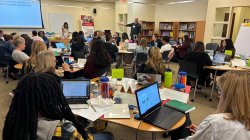CSAM Faculty Host K-12 Teachers to Learn a Novel Approach to Teaching Mathematics
The purpose of the Institute was to promote an innovative instructional routine Drs. Panorkou and Greenstein call Balancing Acts

Dr. Nicole Panorkou and Dr. Steven Greenstein of the Department of Mathematics, along with Associate Dean Scott Kight and doctoral research assistants in Mathematics Education, held a 3-day Summer Institute with 30 elementary and middle school math and science teachers from across 20 New Jersey school districts. These teachers are fellows of the 2024 NJ STEM Innovation Fellowship program.
The Balancing Acts routine is an approach to teaching the concepts of equality and equivalence, which span K-16 education and are fundamental to mathematics and the sciences. Without a solid grounding in these foundational concepts, students will find themselves unprepared for college-level coursework in mathematics and the natural sciences. This can be especially detrimental to STEM students, because without that foundation, they will be less likely to persist in a STEM major and enter the STEM workforce. It is in this regard that in response to an identified need in the math and science knowledge of incoming STEM students at Montclair, Dean Kight called on math education faculty to develop learning experiences to address this critical issue.
The Balancing Acts approach leverages a familiar and ancient technology – the balance scale – as a tool for embodied learning that teachers can use to teach the relational sense of the equal sign. The relational sense of the equal sign promotes a view of an equation as a comparison of two equivalent quantities, as in the equation “8 + 5 = x + 7,” which means that 8 + 5 is the same as an unknown number added to 7. While a variety of tools can and should be used to support students’ learning of equivalence, Dr. Panorkou and Dr. Greenstein hypothesized that the singular use of the balance model across multiple instances of equivalence in the curriculum gives students an “object to think with” that they can rely on to recognize equivalence as a big idea of math and science throughout their K-12 coursework. Here are screenshots of a few activities:

The Summer Institute was held at PRISM, the University’s STEM professional development provider. Its goals were to introduce the Balancing Acts approach to teachers, collaborate with them to design new activities that are tailored to their curriculum, and test and refine pedagogical practices for implementing them in their classrooms. Here’s some of the feedback the teachers shared with us:
I was very honored to be chosen to be a part of this fellowship and proud to share my ideas. The collaboration amongst teachers is inspiring.
I thought the activities were excellent – very engaging and fun. I think students would love them. I thought the sequential way the activities were ordered led to deeper and deeper understanding of the concepts.
The workshop was highly engaging, especially with the focus on hands-on activities, like the Balancing Acts. I found the practical approach and digital resources particularly valuable, as I believe these tools will be incredibly beneficial for the students. I’m looking forward to more interactive learning opportunities!
Dr. Greenstein, Dr. Panorkou, and their doctoral research assistants will continue their professional learning with teachers in monthly meetings throughout the year to further refine the Balancing Acts approach.
